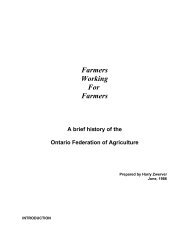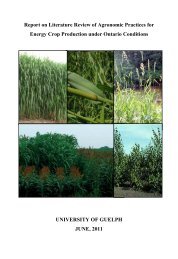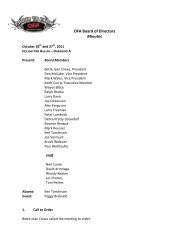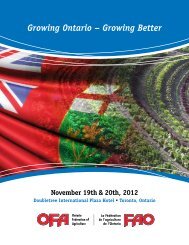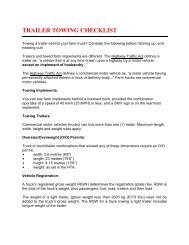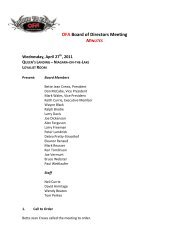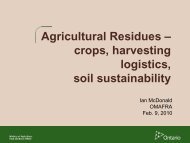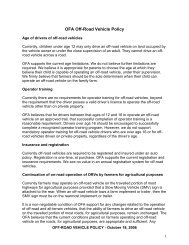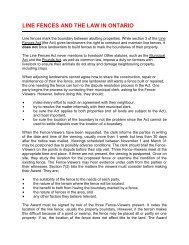Regulatory Compliance Checklist for Employing Farm Workers
Regulatory Compliance Checklist for Employing Farm Workers
Regulatory Compliance Checklist for Employing Farm Workers
Create successful ePaper yourself
Turn your PDF publications into a flip-book with our unique Google optimized e-Paper software.
Employer Responsibilities under the Employment Standards Act, 2000 (ESA)<br />
What is the ESA?<br />
The ESA provides the minimum rights and responsibilities of most employees and employers in<br />
Ontario workplaces. It covers a number of employment standards, including the payment of<br />
wages, hours of work, and termination of employment. Like WSIB premium rate groups, there<br />
are different categories of agricultural workers covered by the ESA, each with their own set of<br />
exemptions or special rules.<br />
Getting Started<br />
The Ministry of Labour publishes two guides to help employers understand their responsibilities<br />
under the ESA. While not specific to farming, the publications, Your Guide to the Employment<br />
Standards Act, 2000, and Complying with the Employment Standards Act (ESA): A Workbook<br />
<strong>for</strong> Employers provide the necessary in<strong>for</strong>mation <strong>for</strong> your workplace.<br />
<strong>Compliance</strong><br />
There are three major ESA categories that farm employers may hire under: <strong>Farm</strong> Employees;<br />
“<strong>Farm</strong> Related Exemptions”; and Harvesters of Fruit, Vegetables and Tobacco. As mentioned<br />
above, each of these categories carries various exemptions and special rules. Most small farms<br />
will hire under the ‘farm employees’ category, but it’s important to refer to the guide to determine<br />
which category your employee best fits and make sure you understand the minimum standards.<br />
If you are planning on hiring a student to work on your farm during the summer break, it is<br />
important to note that there are special rules and exemptions <strong>for</strong> student employees. The<br />
“student employee” category would only apply on your farm if you are hiring the student <strong>for</strong> work<br />
not related to primary production. If the student is working in primary production on the farm,<br />
they will be considered a ‘farm employee’ – basically there’s no special category <strong>for</strong> “student<br />
farm labour”.<br />
Regardless of the ESA job category, all farm employers in Ontario must:<br />
• Keep written records of each employee’s name, address, and employment starting date;<br />
• Establish a regular pay period and a regular payday <strong>for</strong> employees;<br />
• Provide an employee with a wage statement;<br />
• Provide an employee with either written notice of termination, termination pay or a<br />
combination of both when a worker has been employed continuously <strong>for</strong> more than three<br />
months<br />
• Provide an employee with job-protected, statutory leaves of absences<br />
• Provide a qualified employee with severance pay who has his or her employment “severed.<br />
Consequences<br />
The Act gives the Ministry of Labour the power to investigate infractions and en<strong>for</strong>ce the ESA.<br />
The majority of ESA investigations are the result of claims filed by an employee; however<br />
Employment Standards Officers also conduct proactive inspections. Officers have the power to<br />
issue orders to pay wages, compliance orders or tickets, notices of contravention, or initiate<br />
prosecution in severe cases of non-compliance.<br />
The Ontario Federation of Agriculture enables prosperous and sustainable farms.<br />
5



